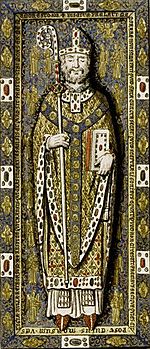Philip of Dreux facts for kids
Quick facts for kids Philip of Dreux |
|
|---|---|
| Bishop of Beauvais | |
 |
|
| Reign | 1175–1217 |
| Predecessor | Bartholomew of Montcornet |
| Successor | Milo of Nanteuil |
| Born | 1158 |
| Died | 4 November 1217 (aged 68–69) |
| Burial | Beauvais Cathedral |
| House | House of Dreux |
| Father | Robert I |
| Mother | Agnes de Baudemont, Countess of Braine |
Philip of Dreux was a French nobleman who lived from 1158 to 1217. He became a bishop and played a part in the Third Crusade. Philip was a brave soldier. He was a cousin and friend to Philip Augustus, the King of France. This meant he often fought against Richard I of England, also known as Richard the Lionheart. As a bishop, he also had duties related to marriages. For example, he helped arrange the marriage of Conrad of Montferrat to Isabella I of Jerusalem during the Siege of Acre. He also helped end the marriage of King Philip Augustus to Ingeborg of Denmark.
Contents
Early Life and Family Connections
Philip was the son of Robert I of Dreux and Agnes of Baudemont. His brother was Robert II of Dreux. His family was important in France.
Adventures in the Crusades
Philip first traveled to the Holy Land in 1180. He joined an expedition led by Henry II of Champagne and Peter I of Courtenay. This trip aimed to challenge Saladin's power, but it did not achieve much.
Later, in 1189, Philip and his brother Robert II arrived in the Holy Land with more soldiers. They joined the Third Crusade, a major effort by European leaders to reclaim land.
Philip and Richard the Lionheart
Richard the Lionheart, the King of England, did not like Philip of Dreux. Philip had spread rumors that Richard was responsible for the death of Conrad of Montferrat.
When Richard was captured and held in Germany, Philip went there. He tried to convince Richard's captors to keep him locked up and treat him badly. This made Richard hate Philip even more. Richard called him "a robber and an incendiary."
Captured and Released
In 1197, Philip was captured by English forces in Normandy. These forces were led by a mercenary named Mercadier and Prince John, Richard's brother. Richard refused to release Philip for a long time.
Even Pope Celestine III was not sympathetic to Philip's situation. Philip was held in Rouen and then in Chinon after trying to escape. He was only set free in 1199, after Richard the Lionheart died. Richard's successor, King John, agreed to exchange Philip for another captured bishop in 1200.
Later Campaigns and Battles
In 1210, Philip took part in a campaign against the Cathars in southern France. The Cathars were a religious group that the Catholic Church considered heretics. Philip supported Simon de Montfort in this fight.
Philip also received support from King Philip Augustus in a conflict against Renaud de Dammartin. This led Renaud to form an alliance with King John of England in 1212.
Philip was a fighter on the winning French side at the Battle of Bouvines in 1214. During this important battle, he used a mace to attack William Longsword, Earl of Salisbury. This action helped lead to the Earl's capture.
Founding a Convent
In his final year as bishop, Philip founded the Pentemont Abbey. This was a Cistercian convent, a place where nuns lived and prayed. The buildings of this convent in Paris still exist today.
Images for kids


